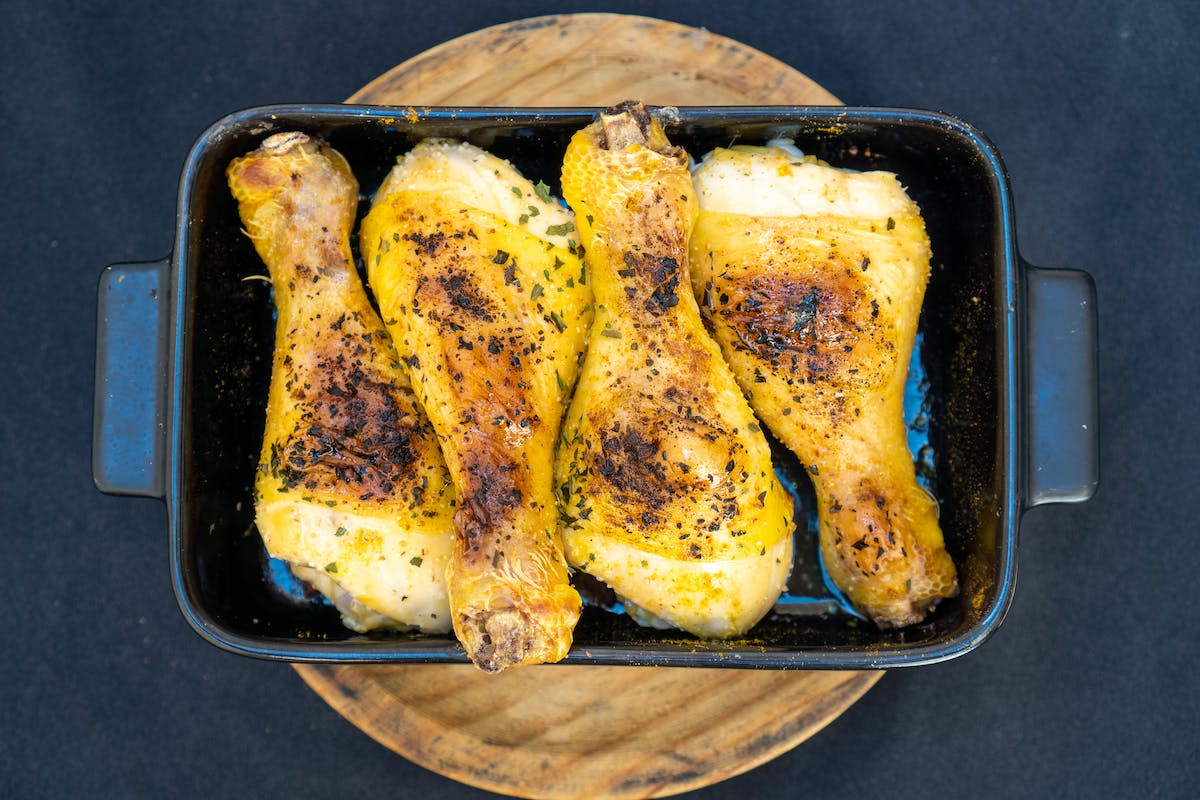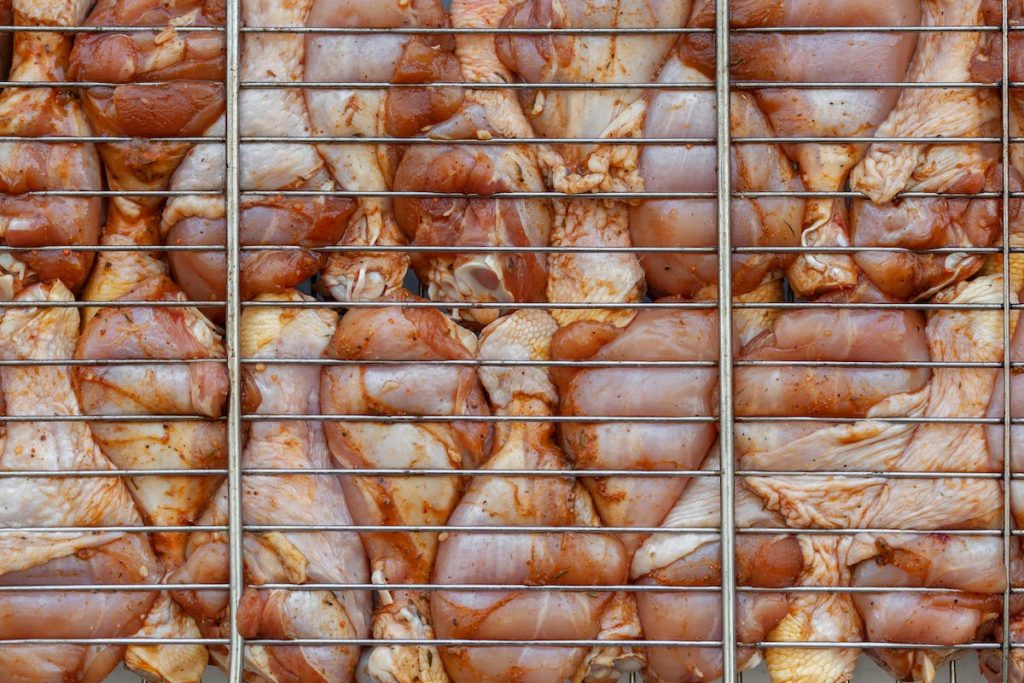Introduction:
Boiling chicken legs is a culinary technique that demonstrates both versatility and simplicity. For those seeking a method that promises tender, flavorful results with minimal fuss, boiling presents an ideal solution. This technique serves to cook the chicken thoroughly and create a rich broth that can be utilized in various recipes, including chicken tenders.
Whether preparing a comforting soup, a hearty stew, or just seeking succulent, easy-to-shred chicken for salads and sandwiches, boiled chicken legs can be the flavorful foundation of numerous dishes. The following sections will detail how long to boil chicken legs for optimal results.
The Appeal of Chicken Legs in Various Cuisines and Dishes
Chicken legs hold a universal appeal across many cuisines around the globe, prized for their rich flavor and juicy texture. From the southern United States to China, chicken legs are a beloved ingredient in a variety of dishes. In the U.S., they often feature in comfort foods like fried chicken and broasted chicken. In Asian cuisines, they are frequently used in robust stews and savory broths imbued with aromatic spices and herbs.
The delectable tenderness of boiled chicken legs makes them popular for dishes requiring shredded chicken, such as salads, enchiladas, and sandwiches. In contrast, broasted chicken legs, with their crispy exterior and succulent interior, are a standalone delicacy in many regions. With their versatility and universally pleasing taste, chicken legs truly reflect the adage that simplicity is the ultimate sophistication in culinary arts.
How to Boil Chicken Legs?
Here’s a step-by-step guide on how to boil chicken legs.
Ingredients and Equipment
Here’s a list of ingredients and equipment needed to boil chicken leg:
- Chicken Legs: The star of this guide. Depending on the number of servings required, the quantity may vary.
- Water: Enough to cover the chicken legs completely in the pot.
- Pot: A large, heavy-bottomed pot is ideal for boiling chicken. It should be big enough to comfortably accommodate the chicken legs and the water.
- Seasonings: This could include salt and pepper for basic seasoning. However, to enhance the flavor, consider adding bay leaves, garlic cloves, onion, celery, or even a splash of white wine. The choice of seasonings can be tailored according to personal preference and the final dish in which the chicken will be used.
Preparation and Seasoning
Before you commence boiling, it’s crucial to properly clean and prepare the chicken legs. Begin by thoroughly washing the chicken legs under cold running water. This step helps remove any residual blood or loose skin. Avoid using hot water as it can start cooking the chicken prematurely, leading to uneven results.
After washing, pat the chicken legs dry using paper towels. This is particularly important if you plan to sear the chicken legs before boiling, as it helps achieve a more even and crispy texture. Once the chicken legs are clean and dry, you can move on to the seasoning step. Sprinkle them generously with salt and pepper, ensuring all surfaces are evenly covered. For a more enhanced flavor, consider making small incisions in the chicken legs and inserting garlic or fresh herbs slivers. Now, your chicken legs are ready to be boiled.
Boiling Process
The boiling process is integral to achieving tender, flavorful chicken legs. Place your prepared chicken legs in the pot, ensuring they fit comfortably. Pour enough water into the pot to fully cover the chicken legs. Add any additional seasonings or aromatics you’re using, such as bay leaves, celery, onion, or garlic. These will infuse the chicken and the broth with additional flavor during the boiling process.
Once the pot is ready, place it on the stove over high heat. Allow the water to come to a full boil – you’ll know it’s boiling when you see large bubbles rapidly breaking the surface. Once the water is boiling, reduce the heat to low, enabling the water to maintain a gentle simmer. Simmering, characterized by tiny and slower bubbles, is the key to cooking the chicken legs until they’re tender without overcooking them. Over high heat, the chicken could become tough and rubbery. Therefore, controlling the heat to maintain a steady simmer is crucial for optimal results.
Cover the pot with a lid, leaving a small gap to allow some steam to escape. This helps to regulate the temperature and prevents the pot from boiling over. Now, you can let your chicken legs cook in the pot, absorbing all the wonderful flavors from the seasonings and creating a mouthwatering broth. The duration of this simmering process will be discussed in the next section, titled “How Long to Boil Chicken Legs?”.
Checking Doneness
Checking the doneness of your chicken legs is a crucial step in ensuring your dish’s safety and quality. The most reliable way to do this is by using a meat thermometer. After your chicken legs have been simmering for the recommended boiling time, remove one leg from the pot using tongs and insert the meat thermometer into the thickest part of the leg, making sure not to touch the bone. The USDA recommends an internal temperature of 165°F (74°C) for chicken for safe consumption. If the thermometer reads below this, return the chicken leg to the pot and continue simmering, rechecking the temperature after a few minutes. Once the thermometer reads 165°F (74°C), the chicken legs are thoroughly cooked and safe to eat.
How Long to Boil Chicken Legs?

Here’s a look at the cooking times and factors determining how long to boil chicken legs.
Size and Quantity
The size and quantity of chicken legs you’re cooking at once can significantly impact the cooking time. Generally, larger chicken legs or a larger quantity require a longer boiling time to ensure thorough cooking. If the chicken legs are particularly large, they may need to be boiled longer to reach the recommended internal temperature of 165°F.
Similarly, when boiling many chicken legs simultaneously, the water temperature may decrease when the chicken is added, necessitating a longer time to return to a simmer and fully cook the chicken. Generally, for medium-sized chicken legs boiled in a standard large pot, you should check for doneness around 30 minutes. However, always use a meat thermometer to confirm that the correct internal temperature has been reached to ensure safety and optimal taste.
Frozen vs. Thawed Chicken
Whether your chicken legs are frozen or thawed can also significantly affect the boiling time. Thawed chicken legs, defrosted in the refrigerator before cooking, generally require less cooking time. As a rough guide, medium-sized thawed chicken legs typically boil for 30-40 minutes.
On the other hand, frozen chicken legs will need a longer boiling time due to the extra time required to thaw and then cook through. You can anticipate that frozen chicken legs may take roughly 50-60 minutes to boil. However, these times can vary depending on the size of the legs and the number of chicken legs you’re cooking at once. Remember, whether your chicken legs are frozen or thawed, always check the internal temperature with a meat thermometer to ensure they reach the safe minimum internal temperature of 165°F before consuming.
High Altitude Considerations
Cooking at high altitudes can also impact the boiling time for chicken legs. At altitudes above 2,000 feet, the lower atmospheric pressure reduces the boiling point of water, which means it takes longer to cook food. Therefore, if you are cooking at a high altitude, you may need to increase the boiling time for chicken legs. Always use a meat thermometer to ensure the chicken has reached the recommended internal temperature of 165°F (74°C).
Chicken Legs Nutrition Content
Boiled chicken legs not only provide a delicious base for various dishes, but they also offer several nutritional benefits. Here is a brief overview of the nutrition content in one medium-sized boiled chicken leg:
Protein Content
Chicken legs are an excellent source of high-quality protein crucial for muscle growth, repair, and maintenance. Protein also plays a vital role in supporting immune function and promoting satiety, which can aid in weight management. A medium-sized boiled chicken leg (approximately 69 grams) contains roughly 19 grams of protein. This makes it a significant contributor to the daily protein intake recommended by dietary guidelines. However, it’s crucial to bear in mind that the protein content can vary slightly depending on the exact size of the chicken leg and the cooking method.
Fat and Calories

Chicken legs, compared to leaner cuts like chicken breast, contain a slightly higher amount of fat. However, most of this is unsaturated fat, considered healthier for heart health. A medium-sized boiled chicken leg (approximately 69 grams) contains about 7 grams of total fat. Within this total fat content, about 2 grams is saturated fat, while the remaining is unsaturated fat, including both monounsaturated and polyunsaturated fats.
As for calories, a medium-sized boiled chicken leg provides around 165 calories. It’s crucial to note that this calorie count can vary slightly depending on the size of the chicken leg and the preparation method. While chicken legs contain more calories and fat than leaner cuts, they can still be part of a healthy diet when consumed in moderation and balanced with other nutrient-dense foods.
Vitamins and Minerals
Chicken legs are rich in essential vitamins and minerals that support various bodily functions. They are particularly high in B vitamins, including vitamin B3 (niacin), vitamin B6, and vitamin B12. These vitamins are vital in energy production, neurological function, and red blood cell formation.
In addition to B vitamins, chicken legs are a good source of iron, which is crucial for producing hemoglobin and red blood cells, thus aiding in oxygen transportation throughout the body.
Chicken legs also contain zinc, a mineral vital for immune function, protein synthesis, and DNA formation. Furthermore, zinc aids in wound healing and supports your sense of taste and smell.
Conclusion
Boiling chicken legs is a straightforward process that requires a few key steps: cleaning and seasoning the chicken, ensuring the legs are fully submerged in water along with your chosen seasonings, boiling, and then simmering until the chicken is tender. The duration of boiling is contingent on factors like the size and quantity of the chicken legs, whether they’re frozen or thawed, and high altitude considerations.
In terms of nutrition, chicken legs are an excellent source of high-quality protein, with a single medium-sized leg providing about 19 grams. While they contain a higher amount of fat than leaner cuts, most of this fat is heart-healthy unsaturated fat. Chicken legs also offer a wealth of essential vitamins and minerals, including B vitamins, iron, and zinc.

